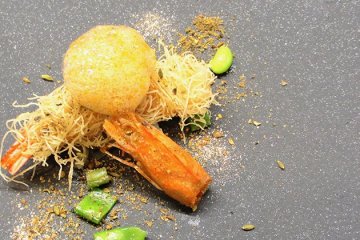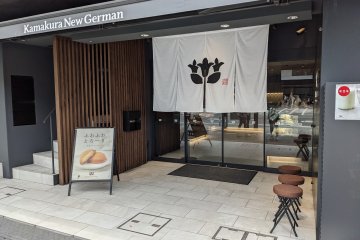
Nature et Sens
在富有创意的法国餐厅 Nature et Sens,用餐者可以完全享受感官体验。时令食材和镰仓农产品在这些精美绝伦的菜肴中占据最关键的位置。您可以在用餐时在选择极多的葡萄酒收藏中,挑选一杯享用。

Tsurugaoka Hachimangu Shrine is arguably the most important shrine in Kamakura and is located roughly in the center of the city. The shrine was originally founded in 1063 by Minamoto Yoriyoshi, the head of Japan’s Minamoto Clan, and was later moved in 1180 to its current location by Minamoto Yoritomo, the founder and first shogun of the Kamakura shogunate. This relocation marked the start of samurai society and Kamakura as a spiritual and social center of Japan. This rich history and culture is still present in Kamakura today.
The shrine is dedicated to Hachiman, the guardian deity of samurai and the Minamoto Clan. Hachiman is worshiped for good fortune in warfare.
The long pathway to the shrine runs through Kamakura City and is marked by multiple red torii gates, showing an interconnectedness between spirituality and urban life. Upon entering the shrine grounds, you will see two ponds on either side of you. The pond on the left represents the Minamoto clan, and the one on the right represents the Taira Clan (Minamoto’s rival). The Taira pond purposefully has four islands in it, which symbolizes the bad blood between the clans as four can be pronounced the same as “death” in Japanese. Beside the Minamoto pond is a beautiful peony garden that is open in winter and spring when the flowers are in full bloom.
Past the ponds you will come across the mai-den, which is located at the base of the stairs to the main hall. This vibrant red building is used as a stage for music and dance performances throughout the year’s festivities. Atop the wide staircase is the main hall. This traditionally designed structure features a red facade with gold-and-green detailing and is a commanding sight due to its massive size. Beside the main hall is a treasure hall that displays historical artifacts such as swords and masks.
The grounds are also home to numerous smaller buildings and shrines, most notably Wakamiya and Maruyama Inari Shrine, which, along with the main hall, are nationally important cultural properties.
Tsurugaoka Hachimangu hosts numerous events throughout the year. One of the shrine’s most popular festivals occurs from September 14th to 16th and features yabusame horseback archery. The shrine is also one of Japan’s most popular spots for hatsumode, which is the first shrine visit of the year.
Tsurugaoka Hachimangu is 10-15 minutes walk from JR Kamakura station (take the east exit).

在富有创意的法国餐厅 Nature et Sens,用餐者可以完全享受感官体验。时令食材和镰仓农产品在这些精美绝伦的菜肴中占据最关键的位置。您可以在用餐时在选择极多的葡萄酒收藏中,挑选一杯享用。

品尝过 Aratama 著名的炸猪排后,你一定会爱上这种新鲜的味道。除了炸猪排之外,餐厅还提供了多样的选择。你一定要尝尝 Aratama 的其他菜肴,如马苏里拉芝士炸肉饼和奶油炸肉饼。


Kenchoji is Kamakura’s oldest Zen temple and is recognized as the top temple of the city’s Five Great Zen Temples. It was originally founded by regent Hojo Tokiyori in 1253 as a Zen training temple, and its first head priest was a Chinese Zen priest named Rankei Doryu. One of Kenchoji’s defining characteristics is its expansive temple grounds. After the gates and main area, the complex extends deep into the wooded hills. The temple’s main buildings feature traditional Chinese architecture and are arranged in a line, which is characteristic of Chinese Zen Buddhist temples. Kenchoji’s entrance is marked by Somon, a relatively small, yet beautiful, wooden gate that leads to the main gate, Sanmon. This massive wooden structure is meant to relieve you of all your attachments. Just past Sanmon and to the right is the temple’s bell tower, and to the left is a revered juniper tree. This 13-meter-tall tree is estimated to be about 760 years old and allegedly sprouted from seeds brought from China during the temple’s construction. After the gates, the temple buildings stand in a line down the complex. First is Butsuden (Buddha Hall), which enshrines the principal statue of the temple, Jizo Bodhisattva. Directly behind Butsuden is Hatto, the largest wooden temple building in Eastern Japan. When Kenchoji was strictly a training temple, monks would gather in Hatto to listen to priests’ lectures. Inside Hatto is a statue of Senju Kannon and a stunning ceiling painting of a dragon among the clouds. Past Hatto is Hojo; this building was initially the head priest’s residence, but today is popular for its picturesque Zen garden. Sanmon, the bell tower, Butsuden, and Hatto are all designated as National Important Cultural Properties. After the main temple grounds, a path goes further into the forested hillside to Hansobo. This small shrine is dedicated to Hansobo Daigongen, the guardian deity of the temple, and has a small observation deck. A little further past the shrine is a second observation deck where you can observe Mount Fuji on clear days. From this point, there is a one-hour hiking trail that leads to Zuisenji Temple.

Myohonji, located in the heart of Kamakura, is one of the oldest Nichiren-sect temples of Japanese Buddhism. Despite its city location, the temple is renowned for its tranquil atmosphere and lush encircling nature. It also tends to be less touristy than other temples in the area. Myohonji was founded in 1260 by Hiki Yoshimoto after he encountered the Buddhist priest and philosopher Nichiren Shonin in Kamakura. The site of the temple was previously home to the Hiki clan, before they were defeated by the Hojo clan in the early 1200s. Hiki Yoshikazu donated his home to Nichiren Shonin for the souls of his fallen clan, which later grew to be Myohonji. Some notable structures include Soshido, Myohonji’s largest temple building, Nitenmon gate, a beautiful inner gate, and a bronze statue of Nichiren. Enjoy the temple grounds in all seasons with spring cherry blossoms, verdant summer foliage, fiery autumn maple and ginkgo leaves, and winter plum blossoms.

Hongakuji Temple (本覚寺) is dedicated to Ebisu, part of the Kamakura seven deities of good luck. The temple was founded by Ashikaga Mochiuji in 1436.